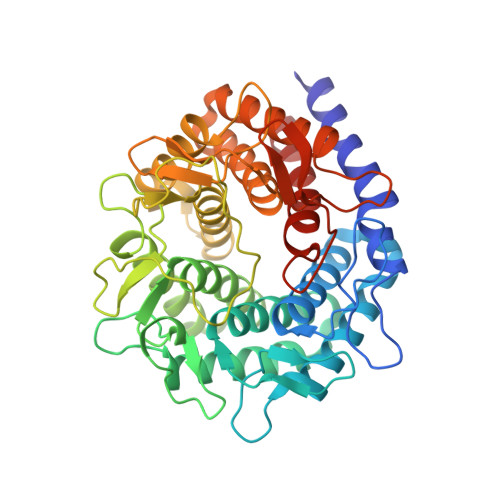Structural insights into the substrate specificity and activity of a novel mannose 2-epimerase from Runella slithyformis.
Wang, H., Sun, X., Saburi, W., Hashiguchi, S., Yu, J., Ose, T., Mori, H., Yao, M.(2023) Acta Crystallogr D Struct Biol 79: 585-595
- PubMed: 37314406
- DOI: https://doi.org/10.1107/S205979832300390X
- Primary Citation of Related Structures:
8H1K, 8H1L, 8H1M, 8H1N - PubMed Abstract:
Mannose 2-epimerase (ME), a member of the acylglucosamine 2-epimerase (AGE) superfamily that catalyzes epimerization of D-mannose and D-glucose, has recently been characterized to have potential for D-mannose production. However, the substrate-recognition and catalytic mechanism of ME remains unknown. In this study, structures of Runella slithyformis ME (RsME) and its D254A mutant [RsME(D254A)] were determined in their apo forms and as intermediate-analog complexes [RsME-D-glucitol and RsME(D254A)-D-glucitol]. RsME possesses the (α/α) 6 -barrel of the AGE superfamily members but has a unique pocket-covering long loop (loop α7-α8 ). The RsME-D-glucitol structure showed that loop α7-α8 moves towards D-glucitol and closes the active pocket. Trp251 and Asp254 in loop α7-α8 are only conserved in MEs and interact with D-glucitol. Kinetic analyses of the mutants confirmed the importance of these residues for RsME activity. Moreover, the structures of RsME(D254A) and RsME(D254A)-D-glucitol revealed that Asp254 is vital for binding the ligand in a correct conformation and for active-pocket closure. Docking calculations and structural comparison with other 2-epimerases show that the longer loop α7-α8 in RsME causes steric hindrance upon binding to disaccharides. A detailed substrate-recognition and catalytic mechanism for monosaccharide-specific epimerization in RsME has been proposed.
Organizational Affiliation:
Faculty of Advanced Life Science, Hokkaido University, Kita 10, Nishi 8, Kita-ku, Sapporo 060-0810, Japan.
















